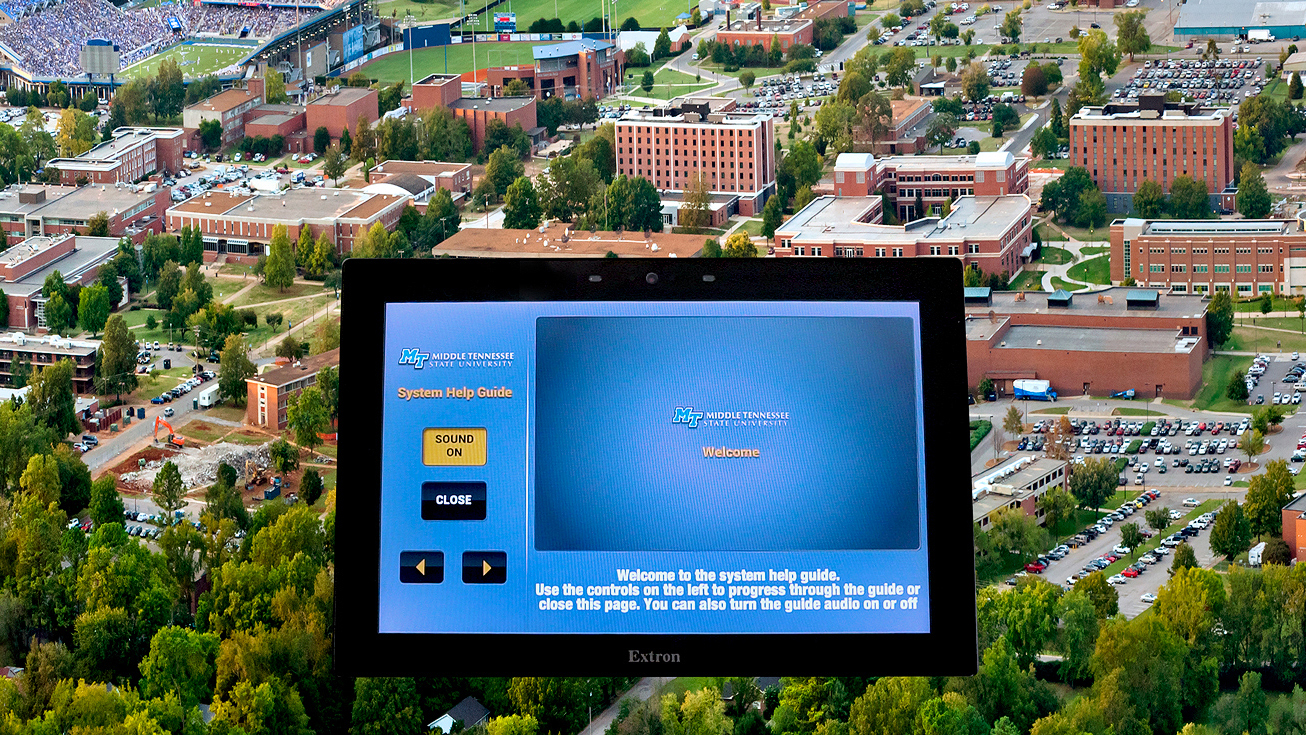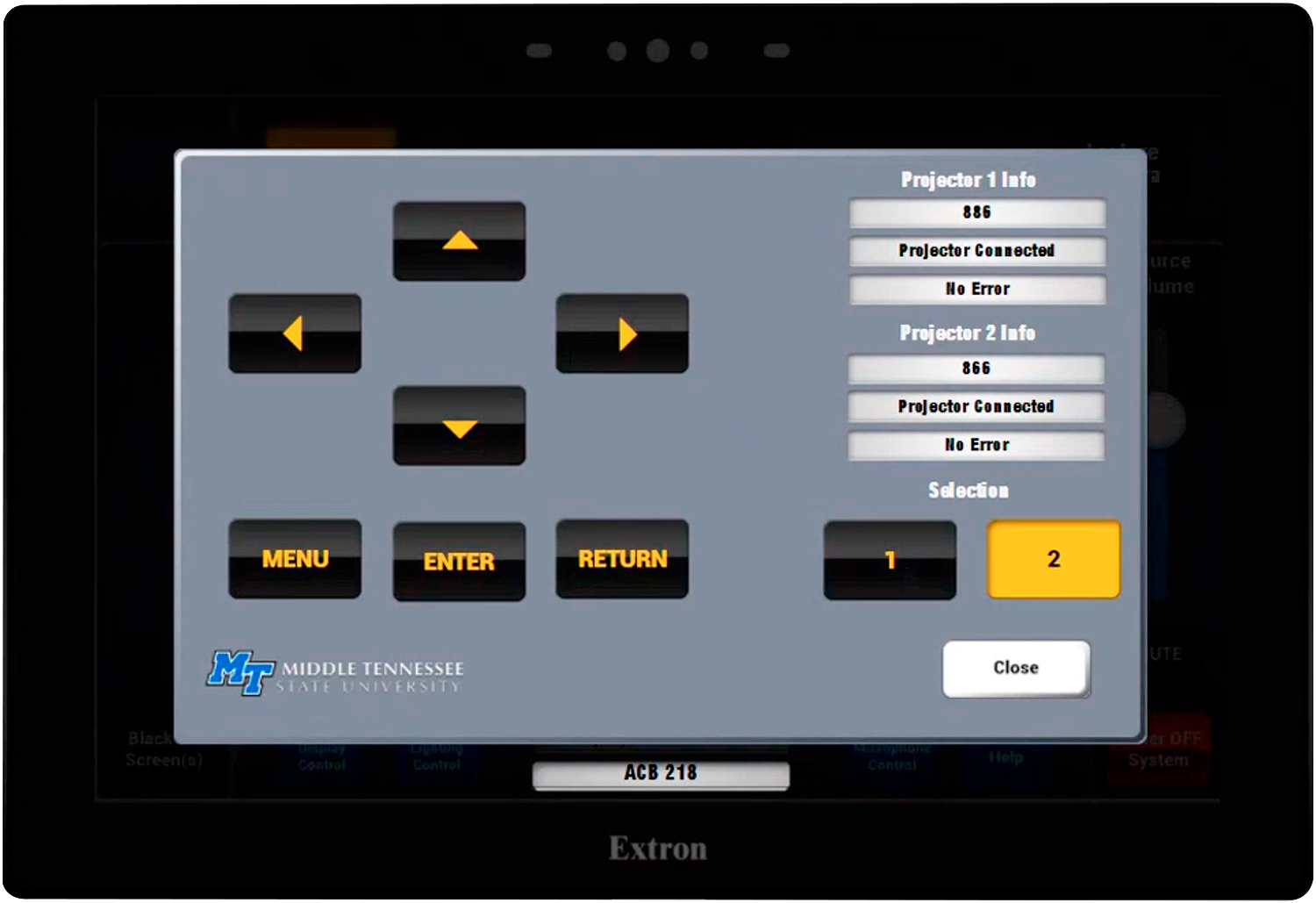Here's How Extron Helps Classrooms with Pro AV Problems Help Themselves
An intuitive TouchLink Pro touchpanel-based user interface enables students and staff to operate and troubleshoot AV issues.

Middle Tennessee State University is a public university founded in 1911 with a two-year program for training teachers. Today, it encompasses eight undergraduate colleges and a college of graduate studies, offering more than 300 undergraduate and graduate degree programs through more than 35 departments. MTSU is well known for its degree programs in music and music recording, aerospace, and a one-of-a-kind degree program in concrete industry management.
Thanks in part to Extron Control Professional Certification and training, MTSU’s IT-AV technical support staff devised an ideal solution. Using Extron Global Configurator Professional and GUI Designer software, they were able to deploy an intuitive TouchLink Pro touchpanel-based user interface. The interface makes it easy for instructors, students, system installers, and technicians to operate and troubleshoot the AV system. The technical support team also leverages the remote AV system management capabilities of GlobalViewer Enterprise software to augment the troubleshooting capabilities built into the touchpanel interface.
[Meet Extron's New Leadership Team]
The Challenge: Solving Problems Remotely
With an undergraduate enrollment of about 20,000 and a 550-acre campus with 55 buildings housing over 420 AV-equipped classrooms, conference rooms, and event spaces, plus more than 1000 university-owned PCs, MTSU’s IT-AV technical support staff is always busy. Many of their help desk calls come from users who need assistance with basic AV system operation or minor troubleshooting. The technical support staff needed a solution that would reduce the number of calls by enabling users to resolve problems themselves.
The Extron Design Solution

Real Time Help That Adjusts Dynamically to the Task
A daily selection of features, industry news, and analysis for AV/IT professionals. Sign up below.
The self-help interface guides non-technical users through routine AV system operations from startup to shutdown in real time with clear, uncluttered interactive GUIs. The GUIs change dynamically for each room, so that all controls available to the user are customized to reflect the makeup of the AV system installed in the room. On-screen hardware status information allows the self-help interface to perform semi-automated interactive troubleshooting sequences for common system issues that can be fixed by users. These can include disconnected cables or forgetting to turn on an AV source device. The opening screen is shown in this article’s sidebar at right. The Help Guide described in the next section explains user interface screens that are seen from that point on.
Animated User Help Guide with Spotlighting, Written and Spoken Explanations
In addition to the real-time guidance built into the control system, users can access an interactive Help Guide from the touchpanel. The guide walks people through all the important user interface screens, spotlighting each button or slider to tap next. Each guide screen includes captions and audio narration explaining each step. The Help Guide obtains hardware status from the AV system servicing each specific room and tailors the content of the guide for that particular room. In this way, the AV system operating instructions presented to the users pertain uniquely to the capabilities of the room they are in. Arrow buttons allow users to navigate forward or back to any page of the Help Guide.
[SCN Top 50 Systems Integrators 2022]
Semi-Automated Troubleshooting
The MTSU technical support staff used Global Configurator Professional to develop an extensive library of troubleshooting macros that save time and money. When triggered by user responses to interactive troubleshooting GUIs on the touchpanel, the macros perform signal tracing to localize the points of possible interruptions in the video or audio signal paths. The macros send commands to the AV system to inject a test signal into the path under test, and monitor status returned from the hardware in the path to detect signal presence. Each node in the signal path is interrogated in this manner until an active signal is located.
Once the point of signal loss is pinpointed, the macro either sends a command to correct the problem or displays a message to the user suggesting how to proceed. The macros emulate the troubleshooting steps and decision branching that a tech support person would perform. If a problem cannot be resolved by the applicable troubleshooting macro, a telephone number and QR code appear on the touchpanel GUI, advising the user to contact tech support at the Help Desk. Tech support can coach the user through manual troubleshooting using the touchpanel, or tech support can take control remotely via GlobalViewer Enterprise.

System Configuration Control Panels for Maintenance and New System Commissioning
A separate set of system configuration control panel touchscreen GUIs is available for advanced AV system troubleshooting, maintenance, and new system commissioning. These GUIs are used by MTSU’s tech support technicians to observe the status of AV system equipment, inject video and audio test signals, and perform initial configuration of the AV system components. Third-party AV systems integrators use the GUIs to program, configure, and commission new systems in accordance with parameter specifications spelled-out in MTSU’s commissioning checklists. Similar to the other self-help touchpanel user interface GUIs, these change dynamically for each room, based on the makeup of the AV system installed in the room. For example, either one or two sets of projector controls are shown on the projector control GUI, depending on whether the room contains single or dual projectors. All the functions contained in these GUIs are also available through GlobalViewer Enterprise, allowing technicians to access these tools from the Help Desk, saving a trip to the room. Four typical configuration control GUIs are shown in this article’s sidebar at right. The configuration control GUIs have become major time savers for MTSU’s tech support team and outside AV system integrators.
Hardware Standardization Makes MTSU’s Self-Help User Interface Development Practical
The self-help interface is extensive and dynamic. It can go through many permutations and combinations based on interactive user selections, branching within troubleshooting logic flows, and the quantity and types of components that comprise the AV system in any given room location.
[SUBSCRIBE to AV Network Newsletters and Publications]
Much of the branching logic performed by the self-help interface programming is based on the AV signal routing performed by the AV switcher. To reduce the time and effort required to program the self-help interface and the overall control system, the MTSU tech support team made a strategic decision to standardize on one AV switcher for all new AV systems. The team determined that the DTP CrossPoint 84 4K 8x4 Scaling Presentation Matrix Switcher offers the best solution in a tradeoff between price and functionality requirements.
Results Are In: Extron Brings Value to End Users
The vision that MTSU’s IT-AV technical support staff had when they embarked on development of the self-help user interface was to automate as many manual processes as possible and provide instructors, students, and other non-technical users with tools to solve minor AV issues quickly on their own.
According to James Copeland, who heads-up the MTSU IT-AV Team as director-classroom technology client services, the self-help user interface made practical by Global Configurator Professional has shown its value for end users and for his own service team. James notes, “Previously instructors would often call us out to the classrooms for issues as simple as a blank screen caused by a PC or document camera that wasn’t turned on. Now, the touchpanel prompts them with ‘Please Power-on the PC’, and when the system then detects an active signal, the touchscreen confirms with ‘PC Signal Detected’. Something this simple has reduced such time-consuming service calls to zero.”
“Student workers who help us in tech support roles have a high turnover rate driven by their class schedules," said Copeland. "We were constantly training new people. The self-help user interface helps reduce the learning curve, allowing us to make efficient use of this transient workforce.” In addition to these benefits, the self-help interface system commissioning tools make third party installers more self-sufficient.
The AVNetwork staff are storytellers focused on the professional audiovisual and technology industry. Their mission is to keep readers up-to-date on the latest AV/IT industry and product news, emerging trends, and inspiring installations.
